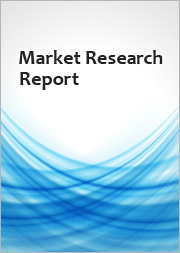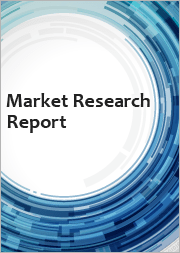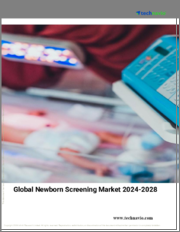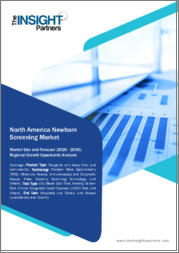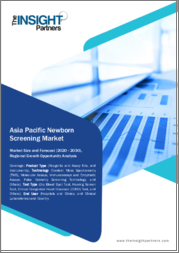
|
시장보고서
상품코드
1463687
아시아태평양의 신생아 스크리닝 시장 예측(2030년) : 지역별 분석 - 제품 유형, 기술, 검사 유형, 최종사용자별Asia Pacific Newborn Screening Market Forecast to 2030 - Regional Analysis - by Product Type (Reagents and Assay Kits, and Instruments), Technology, Test Type, and End User (Hospitals and Clinics, and Diagnostic Laboratories) |
||||||
아시아태평양의 신생아 스크리닝 시장은 2022년에 2억 7,013만 달러로 평가되며, 2030년에는 6억 214만 달러에 달할 것으로 예측되며, 2022-2030년의 CAGR은 10.5%로 성장할 것으로 예측되고 있습니다.
신생아 유전자 스크리닝이 아시아태평양의 신생아 스크리닝 시장을 활성화.
병상의 유전적 원인에 대한 지식이 깊어지고 의료 기술이 발전함에 따라 신생아에 대한 종합적인 유전자 검사에 대한 수요가 증가하고 있습니다. 이에 따라 신생아 스크리닝 시장의 기업은 혁신적이고 비용 효율적인 선별검사 솔루션을 개발하고 있으며, 예스카르타와 진테글로(Zynteglo)는 대세포 B세포 림프종과 베타 지중해빈혈에 대한 승인된 유전자 치료제의 두 가지 예입니다. 또한 출생시 질병에 대한 유전적 소인을 파악할 수 있는 기술의 출현은 맞춤형 의료로 가는 길을 열어주며, 이는 정밀의료의 광범위한 추세와 일치합니다.
임신 중 유전성 질환에 대한 선별검사는 임신과 관련된 문제를 조기에 발견하는 데 중점을 두고 있습니다. 차세대 염기서열 분석기는 모든 염색체에서 다운증후군, 삼염색체 21번과 같은 이수성 및 부분적 염색체 이상(중복 및 결실)을 95% 이상의 민감도로 검출하여 신생아 산전 선별검사를 지원합니다. 형광 in-situ hybridization(FISH)은 겸상 적혈구 빈혈과 같은 단발성 질환을 검출하는 데 사용됩니다. 모체 혈장을 이용한 무세포 태아 DNA 접근법과 같은 비침습적 절차는 유전자 검사의 최근 발전입니다. 배아 DNA는 크기 차이로 인해 모체 DNA 조각과 구별할 수 있습니다. 형광 프로브를 이용한 실시간 PCR, 샷건 시퀀싱(Solexa 또는 Illumina) 또는 거대 표적 병렬 시퀀싱을 통해 태아의 질병과 관련된 DNA를 검사할 수 있습니다. 이러한 유형의 유전자 스크리닝이 더 연구되면, 의사는 특정 약리요법(약리유전학)을 통해 조기에 분자적 개입을 하거나 세포, 조직, 기관에 물리적, 화학적 변화를 줄 수 있게 될 것입니다. 이처럼 영아 유전질환 스크리닝 방법의 발전은 신생아 스크리닝 시장 전체에 엄청난 잠재력을 가지고 있습니다.
아시아태평양의 신생아 스크리닝 시장 개요
아시아태평양의 신생아 스크리닝 시장은 중국, 일본, 인도, 한국 , 호주, 기타 아시아태평양으로 구분됩니다. 아시아태평양의 신생아 스크리닝 시장은 일본, 중국, 인도, 한국 , 호주, 기타 아시아태평양으로 구분됩니다. 아시아태평양은 2022-2030년에 세계의 신생아 스크리닝 시장에서 가장 급성장하는 지역이 될 전망입니다. 이 지역에서 시장의 성장 예측은, 신생아 출생수 양, 선천성 질환의 유병률 급상승, 신생아 선천성 이상의 조기진단에 관한 의식의 향상, 신생아 스크리닝을 위한 더 나은 솔루션의 제공을 위해 활동하고 있는 조직의 존재와 관련이 있습니다.
아시아태평양에서 신생아 스크리닝은 견인력을 늘리고 있으며, 중국, 인도, 기타 국가 정부기관은 높은 출산율로 인해 신생아 스크리닝 프로그램을 실시해야 합니다. 유엔아동기금(UNICEF)에 따르면 인도에서는 하루에 67,385명의 아기가 태어나고 있으며, 이는 전 세계에서 하루에 기록되는 출산의 6분의 1을 차지합니다. 또한 Worldmapper에 따르면 2022년에는 2300만 명, 그 다음이 중국으로 1,000만 명의 아기가 태어날 것으로 예상하고 있습니다. 출산율이 지속적으로 상승함에 따라 아시아태평양의 다른 국가와 마찬가지로 인도에서도 영유아 보육에 대한 관심이 높아지고 있습니다.
아시아태평양의 신생아 스크리닝 시장의 매출과 2030년까지의 예측(금액)
아시아태평양의 신생아 스크리닝 시장 세분화
아시아태평양의 신생아 스크리닝 시장은 제품 유형, 기술, 검사 유형, 최종사용자, 국가에 의해 구분됩니다.
제품 유형별로 보면 아시아태평양의 신생아 스크리닝 시장은 시약·어세이 키트와 기기로 2분됩니다. 2022년 아시아태평양의 신생아 스크리닝 시장 점유율은 시약·어세이 키트 부문이 커지고 있습니다. 시약·어세이 키트 분야는 DNA 기반 어세이, 면역 어세이, 효소 어세이로 세분화됩니다. 기기 부문은 신생아 장애 스크리닝 기기, 펄스옥시미터, 신생아 청각 스크리닝 기기, 기타 기기로 세분화됩니다.
기술면에서는 아시아태평양의 신생아 스크리닝 시장은 탠덤 질량분석(TMS), 분자 어세이, 면역 어세이와 효소 어세이, 펄스 옥시메트리 스크리닝 기술, 기타 기술로 분류됩니다. 펄스 옥시메트리 스크리닝 기술 부문은 2022년에 아시아태평양의 신생아 스크리닝 시장에서 최대 점유율을 차지했습니다.
검사 유형에 기반하여 아시아태평양의 신생아 스크리닝 시장은 건조혈반 검사, 청각 스크린 검사, 중증 선천성 심질환(CCHD) 검사, 기타 검사 유형으로 분류됩니다. 2022년에는 건조혈반 검사 분야가 아시아태평양의 신생아 스크리닝 시장에서 최대 점유율을 차지했습니다.
최종사용자별로는 아시아태평양의 신생아 스크리닝 시장은 병원·진료소로 진단 연구소로 구분됩니다. 병원·진료소 부문은 2022년에 아시아태평양의 신생아 스크리닝 시장에서 보다 큰 점유율을 차지했습니다.
국가별로는 아시아태평양의 신생아 스크리닝 시장은 중국, 일본, 인도 , 호주, 한국, 기타 아시아태평양으로 분류됩니다. 중국은 2022년에 아시아태평양의 신생아 스크리닝 시장을 독점했습니다.
Bio-Rad Laboratories Inc, LifeCell International Pvt Ltd, Masimo Corp, Medtronic Plc, Natus Medical Inc, PerkinElmer Inc, Trivitron Healthcare Pvt Ltd, Waters Corp는 아시아태평양의 신생아 스크리닝 시장에서 사업을 운영하고 있는 대기업의 일부입니다.
목차
목차
제1장 서론
제2장 주요 요약
- 주요 인사이트
제3장 조사 방법
- 조사 범위
- 2차 조사
- 1차 조사
제4장 아시아태평양의 신생아 스크리닝 시장 : 주요 산업 역학
- 시장 촉진요인
- 신생아 스크리닝에 대한 정부 자금의 급증
- 선천성 질환의 부담 증가
- 신생아 질환의 유병률 증가
- 주요 시장 억제요인
- 신생아 스크리닝 정책과 시행에서 통일성의 결여
- 주요 시장 기회
- 신생아 유전자 스크리닝
- 향후 동향
- 스크리닝에서 기계학습과 인공지능의 통합
- 영향 분석
제5장 신생아 스크리닝 시장 : 아시아태평양 시장 분석
- 아시아태평양의 신생아 스크리닝 시장 판매고, 2022-2030년
제6장 아시아태평양의 신생아 스크리닝 시장 : 매출과 2030년까지의 예측 : 제품 유형별
- 아시아태평양의 신생아 스크리닝 시장 : 제품 유형별 판매고 점유율(2022-2030년)
- 시약 및 어세이 키트
- 검사기기
제7장 아시아태평양의 신생아 스크리닝 시장 : 매출과 2030년까지의 예측 : 기술별
- 아시아태평양의 신생아 스크리닝 시장 : 2022년·2030년 기술별 판매고 점유율(%)
- 탠덤 질량분석(TMS)
- 분자 어세이
- 면역 어세이 및 효소 어세이
- 펄스 옥시메트리 스크리닝 기술
- 기타 기술
제8장 아시아태평양의 신생아 스크리닝 시장 : 매출과 2030년까지의 예측 : 검사 유형별
- 아시아태평양의 신생아 스크리닝 시장 : 2022년 및 2030년 검사 유형별 판매고 점유율(%)
- 건조혈반 검사
- 청각 스크리닝 검사
- 중증 선천성 심질환(CCHD) 검사
- 기타 검사 유형
제9장 아시아태평양의 신생아 스크리닝 시장 : 최종사용자별 매출과 2030년까지의 예측
- 아시아태평양의 신생아 스크리닝 시장 : 2022년 및 2030년 최종사용자별 판매고 점유율(%)
- 병원 및 진료소
- 진단 연구소
제10장 아시아태평양의 신생아 스크리닝 시장 : 국가별 분석
- 중국
- 일본
- 인도
- 호주
- 한국
- 기타 아시아태평양
제11장 아시아태평양의 신생아 스크리닝 시장 - 업계 상황
- 신생아 스크리닝 시장에서의 성장 전략
- 유기적 성장 전략
- 무기적 성장 전략
제12장 기업 개요
- LifeCell International Pvt Ltd
- Trivitron Healthcare Pvt Ltd
- PerkinElmer Inc
- Waters Corp
- Bio-Rad Laboratories Inc
- Masimo Corp
- Natus Medical Inc.
- Medtronic Plc
제13장 부록
KSA 24.04.26The Asia Pacific newborn screening market was valued at US$ 270.13 million in 2022 and is expected to reach US$ 602.14 million by 2030; it is estimated to grow at a CAGR of 10.5% from 2022 to 2030.
Genetic Screening of Newborns Fuels the Asia Pacific Newborn Screening Market.
The demand for comprehensive genetic screening of newborns is rising with the deepening knowledge about the genetic causes of medical conditions and advancements in healthcare technologies. As a result, companies in the newborn screening market are developing innovative, cost-effective screening solutions. Yescarta and Zynteglo are two examples of authorized gene treatments for large B-cell lymphoma and beta-thalassemia. Further, the emergence of technologies conferring an ability to identify genetic predispositions to diseases at birth pave the way for personalized healthcare, aligning with the broader trend of precision medicine.
Screening for genetic diseases during pregnancy also focuses on the early detection of pregnancy-related problems. Next-generation sequencing aids in the prenatal screening of neonates with a sensitivity of above 95% for detecting aneuploidies (such as Down syndrome and Trisomy 21) or partial chromosomal abnormalities (duplications or deletions) in all chromosomes. Fluorescence in-situ hybridization (FISH) is employed to detect monogenic illnesses such as sickle cell anemia; it also aids in an effective preimplantation genetic diagnosis. Noninvasive procedures such as the cell-free fetal DNA approach using maternal plasma are the recent advancements in genetic tests. The embryonic DNA can be distinguished from maternal DNA pieces based on differences in their sizes. Real-time PCR with fluorescent probes, shotgun sequencing (Solexa or Illumina), or huge targeted parallel sequencing can be used to examine DNA associated with fetal medical conditions. This would allow doctors to provide early molecular interventions with certain pharmacological therapies (pharmacogenetics) and to transform cells, tissues, and organs physically and chemically if this type of genetic screening is further researched. Thus, advancements in methods for screening infants for genetic disorders hold immense potential for the overall newborn screening market.
Asia Pacific Newborn Screening Market Overview
The newborn screening market in Asia Pacific is segmented into China, Japan, India, South Korea, Australia, and the Rest of Asia Pacific. The Asia -Pacific newborn screening market is segmented into Japan, China, India, South Korea, Australia, and the Rest of Asia -Pacific. Asia -Pacific is expected to be the fastest-growing region in the global newborn screening market during 2022-2030. The projected growth of the market in this region can be associated with the high number of newborn births, the soaring prevalence of congenital diseases, rising awareness regarding early diagnosis of birth defects in newborns, and the presence of organizations working toward offering better solutions for newborn screening.
Screening of newborns in Asia -Pacific is gaining traction; government agencies in China, India, and other countries need to implement newborn screening programs owing to the high birth rate. According to the United Nations International Children's Emergency Fund (UNICEF), 67,385 babies are born in India each day, accounting for one-sixth of childbirths recorded globally in a day. In addition, India has become the most populated nation; as per Worldmapper, ~23 million babies were born in 2022, followed by China with the birth of 10 million babies. With the constantly soaring birth rate, the focus on infant care is increasing in India, as well as in other countries in Asia -Pacific.
Asia Pacific Newborn Screening Market Revenue and Forecast to 2030 (US$ Million)
Asia Pacific Newborn Screening Market Segmentation
The Asia Pacific newborn screening market is segmented based on product type, technology, test type, end user, and country.
Based on product type, the Asia Pacific newborn screening market is bifurcated into reagents and assay kits, and instruments. The reagents and assay kits segment held a larger Asia Pacific newborn screening market share in 2022. The reagents and assay kits segment is subsegmented into DNA-based assays, and immunoassays and enzymatic assays. Instruments segment is subsegmented into newborn disorder screening instruments, pulse oximeters, newborn hearing screening instruments, and other instruments.
In terms of technology, the Asia Pacific newborn screening market is categorized into tandem mass spectrometry (TMS), molecular assays, immunoassays and enzymatic assay, pulse oximetry screening technology, and other technologies. The pulse oximetry screening technology segment held the largest Asia Pacific newborn screening market share in 2022.
Based on test type, the Asia Pacific newborn screening market is categorized into dry blood spot test, hearing screen test, critical congenital heart diseases (CCHD) test, and other test types. The dry blood spot test segment held the largest Asia Pacific newborn screening market share in 2022.
By end user, the Asia Pacific newborn screening market is segmented into hospitals and clinics and diagnostic laboratories. The hospitals and clinics segment held a larger Asia Pacific newborn screening market share in 2022.
Based on country, the Asia Pacific newborn screening market is categorized into China, Japan, India, Australia, South Korea, and the Rest of Asia Pacific. China dominated the Asia Pacific newborn screening market in 2022.
Bio-Rad Laboratories Inc, LifeCell International Pvt Ltd, Masimo Corp, Medtronic Plc, Natus Medical Inc, PerkinElmer Inc, Trivitron Healthcare Pvt Ltd, and Waters Corp are some of the leading companies operating in the Asia Pacific newborn screening market.
Table Of Contents
Table of Content
1. Introduction
- 1.1 The Insight Partners Research Report Guidance
- 1.2 Market Segmentation
2. Executive Summary
- 2.1 Key Insights
3. Research Methodology
- 3.1 Coverage
- 3.2 Secondary Research
- 3.3 Primary Research
4. Asia Pacific Newborn Screening Market - Key Industry Dynamics
- 4.1 Key Market Drivers
- 4.1.1 Surging Government Funding for Newborn Screening
- 4.1.2 Rising Burden of Congenital Diseases
- 4.1.3 Increasing Prevalence of Newborn Disorders
- 4.2 Key Market Restraints
- 4.2.1 Lack of Uniformity in Newborn Screening Policies and Practices
- 4.3 Key Market Opportunities
- 4.3.1 Genetic Screening of Newborns
- 4.4 Future Trends
- 4.4.1 Integration of Machine Learning and Artificial Intelligence in Screening
- 4.5 Impact Analysis:
5. Newborn Screening Market - Asia Pacific Market Analysis
- 5.1 Asia Pacific Newborn Screening Market Revenue (US$ Mn), 2022 - 2030
6. Asia Pacific Newborn Screening Market - Revenue and Forecast to 2030 - by Product Type
- 6.1 Overview
- 6.2 Asia Pacific Newborn Screening Market Revenue Share, by Product Type, 2022 & 2030 (%)
- 6.3 Reagents and Assay Kits
- 6.3.1 Overview
- 6.3.2 Reagents and Assay Kits: Asia Pacific Newborn Screening Market - Revenue and Forecast to 2030 (US$ Million)
- 6.3.2.1 Asia Pacific Newborn Screening Market, by Reagents and Assay Kits, 2020-2030 (US$ Million)
- 6.4 Instruments
- 6.4.1 Overview
- 6.4.2 Instruments: Asia Pacific Newborn Screening Market - Revenue and Forecast to 2030 (US$ Million)
- 6.4.2.1 Asia Pacific Newborn Screening Market, by Instruments, 2020-2030 (US$ Million)
7. Asia Pacific Newborn Screening Market - Revenue and Forecast to 2030 - by Technology
- 7.1 Overview
- 7.2 Asia Pacific Newborn Screening Market Revenue Share, by Technology 2022 & 2030 (%)
- 7.3 Tandem Mass Spectrometry (TMS)
- 7.3.1 Overview
- 7.3.2 Tandem Mass Spectrometry (TMS): Asia Pacific Newborn Screening Market - Revenue and Forecast to 2030 (US$ Million)
- 7.4 Molecular Assays
- 7.4.1 Overview
- 7.4.2 Molecular Assays: Asia Pacific Newborn Screening Market - Revenue and Forecast to 2030 (US$ Million)
- 7.5 Immunoassays and Enzymatic Assays
- 7.5.1 Overview
- 7.5.2 Immunoassays and Enzymatic Assays: Asia Pacific Newborn Screening Market - Revenue and Forecast to 2030 (US$ Million)
- 7.6 Pulse Oximetry Screening Technology
- 7.6.1 Overview
- 7.6.2 Pulse Oximetry Screening Technology: Asia Pacific Newborn Screening Market - Revenue and Forecast to 2030 (US$ Million)
- 7.7 Other Technologies
- 7.7.1 Overview
- 7.7.2 Other Technologies: Asia Pacific Newborn Screening Market - Revenue and Forecast to 2030 (US$ Million)
8. Asia Pacific Newborn Screening Market - Revenue and Forecast to 2030 - by Test Type
- 8.1 Overview
- 8.2 Asia Pacific Newborn Screening Market Revenue Share, by Test Type 2022 & 2030 (%)
- 8.3 Dry Blood Spot Test
- 8.3.1 Overview
- 8.3.2 Dry Blood Spot Test: Asia Pacific Newborn Screening Market - Revenue and Forecast to 2030 (US$ Million)
- 8.4 Hearing Screen Test
- 8.4.1 Overview
- 8.4.2 Hearing Screen Test: Asia Pacific Newborn Screening Market - Revenue and Forecast to 2030 (US$ Million)
- 8.5 Critical Congenital Heart Diseases (CCHD) Test
- 8.5.1 Overview
- 8.5.2 Critical Congenital Heart Diseases (CCHD) Test: Asia Pacific Newborn Screening Market - Revenue and Forecast to 2030 (US$ Million)
- 8.6 Other Test Types
- 8.6.1 Overview
- 8.6.2 Other Test Types: Asia Pacific Newborn Screening Market - Revenue and Forecast to 2030 (US$ Million)
9. Asia Pacific Newborn Screening Market - Revenue and Forecast to 2030 - by End User
- 9.1 Overview
- 9.2 Asia Pacific Newborn Screening Market Revenue Share, by End User, 2022 & 2030 (%)
- 9.3 Hospitals and Clinics
- 9.3.1 Overview
- 9.3.2 Hospitals and Clinics: Asia Pacific Newborn Screening Market - Revenue and Forecast to 2030 (US$ Million)
- 9.4 Diagnostic Laboratories
- 9.4.1 Overview
- 9.4.2 Diagnostic Laboratories: Asia Pacific Newborn Screening Market - Revenue and Forecast to 2030 (US$ Million)
10. Asia Pacific Newborn Screening Market - Country Analysis
- 10.1 Asia Pacific Newborn Screening Market, Revenue and Forecast to 2030
- 10.1.1 Overview
- 10.1.2 Asia Pacific Newborn Screening Market, by Country
- 10.1.2.1 China
- 10.1.2.1.1 China Newborn Screening Market Revenue and Forecast to 2030 (US$ Mn)
- 10.1.2.1.2 China: Newborn Screening Market, by Product Type, 2020-2030 (US$ Million)
- 10.1.2.1.2.1 China: Newborn Screening Market, For Reagents and Assay Kits by Product Type, 2020-2030 (US$ Million)
- 10.1.2.1.2.2 China: Newborn Screening Market, For Instruments by Product Type, 2020-2030 (US$ Million)
- 10.1.2.1.3 China: Newborn Screening Market, by Technology, 2020-2030 (US$ Million)
- 10.1.2.1.4 China: Newborn Screening Market, by Test Type, 2020-2030 (US$ Million)
- 10.1.2.1.5 China: Newborn Screening Market, by End User, 2020-2030 (US$ Million)
- 10.1.2.2 Japan
- 10.1.2.2.1 Japan Newborn Screening Market Revenue and Forecast to 2030 (US$ Mn)
- 10.1.2.2.2 Japan: Newborn Screening Market, by Product Type, 2020-2030 (US$ Million)
- 10.1.2.2.2.1 Japan: Newborn Screening Market, For Reagents and Assay Kits by Product Type, 2020-2030 (US$ Million)
- 10.1.2.2.2.2 Japan: Newborn Screening Market, For Instruments by Product Type, 2020-2030 (US$ Million)
- 10.1.2.2.3 Japan: Newborn Screening Market, by Technology, 2020-2030 (US$ Million)
- 10.1.2.2.4 Japan: Newborn Screening Market, by Test Type, 2020-2030 (US$ Million)
- 10.1.2.2.5 Japan: Newborn Screening Market, by End User, 2020-2030 (US$ Million)
- 10.1.2.3 India
- 10.1.2.3.1 India Newborn Screening Market Revenue and Forecast to 2030 (US$ Mn)
- 10.1.2.3.2 India: Newborn Screening Market, by Product Type, 2020-2030 (US$ Million)
- 10.1.2.3.2.1 India: Newborn Screening Market, For Reagents and Assay Kits by Product Type, 2020-2030 (US$ Million)
- 10.1.2.3.2.2 India: Newborn Screening Market, For Instruments by Product Type, 2020-2030 (US$ Million)
- 10.1.2.3.3 India: Newborn Screening Market, by Technology, 2020-2030 (US$ Million)
- 10.1.2.3.4 India: Newborn Screening Market, by Test Type, 2020-2030 (US$ Million)
- 10.1.2.3.5 India: Newborn Screening Market, by End User, 2020-2030 (US$ Million)
- 10.1.2.4 Australia
- 10.1.2.4.1 Australia Newborn Screening Market Revenue and Forecast to 2030 (US$ Mn)
- 10.1.2.4.2 Australia: Newborn Screening Market, by Product Type, 2020-2030 (US$ Million)
- 10.1.2.4.2.1 Australia: Newborn Screening Market, For Reagents and Assay Kits by Product Type, 2020-2030 (US$ Million)
- 10.1.2.4.2.2 Australia: Newborn Screening Market, For Instruments by Product Type, 2020-2030 (US$ Million)
- 10.1.2.4.3 Australia: Newborn Screening Market, by Technology, 2020-2030 (US$ Million)
- 10.1.2.4.4 Australia: Newborn Screening Market, by Test Type, 2020-2030 (US$ Million)
- 10.1.2.4.5 Australia: Newborn Screening Market, by End User, 2020-2030 (US$ Million)
- 10.1.2.5 South Korea
- 10.1.2.5.1 South Korea Newborn Screening Market Revenue and Forecast to 2030 (US$ Mn)
- 10.1.2.5.2 South Korea: Newborn Screening Market, by Product Type, 2020-2030 (US$ Million)
- 10.1.2.5.2.1 South Korea: Newborn Screening Market, For Reagents and Assay Kits by Product Type, 2020-2030 (US$ Million)
- 10.1.2.5.2.2 South Korea: Newborn Screening Market, For Instruments by Product Type, 2020-2030 (US$ Million)
- 10.1.2.5.3 South Korea: Newborn Screening Market, by Technology, 2020-2030 (US$ Million)
- 10.1.2.5.4 South Korea: Newborn Screening Market, by Test Type, 2020-2030 (US$ Million)
- 10.1.2.5.5 South Korea: Newborn Screening Market, by End User, 2020-2030 (US$ Million)
- 10.1.2.6 Rest of Asia Pacific
- 10.1.2.6.1 Rest of Asia Pacific Newborn Screening Market Revenue and Forecast to 2030 (US$ Mn)
- 10.1.2.6.2 Rest of Asia Pacific: Newborn Screening Market, by Product Type, 2020-2030 (US$ Million)
- 10.1.2.6.2.1 Rest of Asia Pacific: Newborn Screening Market, For Reagents and Assay Kits by Product Type, 2020-2030 (US$ Million)
- 10.1.2.6.2.2 Rest of Asia Pacific: Newborn Screening Market, For Instruments by Product Type, 2020-2030 (US$ Million)
- 10.1.2.6.3 Rest of Asia Pacific: Newborn Screening Market, by Technology, 2020-2030 (US$ Million)
- 10.1.2.6.4 Rest of Asia Pacific: Newborn Screening Market, by Test Type, 2020-2030 (US$ Million)
- 10.1.2.6.5 Rest of Asia Pacific: Newborn Screening Market, by End User, 2020-2030 (US$ Million)
- 10.1.2.1 China
11. Asia Pacific Newborn Screening Market-Industry Landscape
- 11.1 Overview
- 11.2 Growth Strategies in Newborn Screening Market
- 11.3 Organic Growth Strategies
- 11.3.1 Overview
- 11.4 Inorganic Growth Strategies
- 11.4.1 Overview
12. Company Profiles
- 12.1 LifeCell International Pvt Ltd
- 12.1.1 Key Facts
- 12.1.2 Business Description
- 12.1.3 Products and Services
- 12.1.4 Financial Overview
- 12.1.5 SWOT Analysis
- 12.1.6 Key Developments
- 12.2 Trivitron Healthcare Pvt Ltd
- 12.2.1 Key Facts
- 12.2.2 Business Description
- 12.2.3 Products and Services
- 12.2.4 Financial Overview
- 12.2.5 SWOT Analysis
- 12.2.6 Key Developments
- 12.3 PerkinElmer Inc
- 12.3.1 Key Facts
- 12.3.2 Business Description
- 12.3.3 Products and Services
- 12.3.4 Financial Overview
- 12.3.5 SWOT Analysis
- 12.3.6 Key Developments
- 12.4 Waters Corp
- 12.4.1 Key Facts
- 12.4.2 Business Description
- 12.4.3 Products and Services
- 12.4.4 Financial Overview
- 12.4.5 SWOT Analysis
- 12.4.6 Key Developments
- 12.5 Bio-Rad Laboratories Inc
- 12.5.1 Key Facts
- 12.5.2 Business Description
- 12.5.3 Products and Services
- 12.5.4 Financial Overview
- 12.5.5 SWOT Analysis
- 12.5.6 Key Developments
- 12.6 Masimo Corp
- 12.6.1 Key Facts
- 12.6.2 Business Description
- 12.6.3 Products and Services
- 12.6.4 Financial Overview
- 12.6.5 SWOT Analysis
- 12.6.6 Key Developments
- 12.7 Natus Medical Inc.
- 12.7.1 Key Facts
- 12.7.2 Business Description
- 12.7.3 Products and Services
- 12.7.4 Financial Overview
- 12.7.5 SWOT Analysis
- 12.7.6 Key Developments
- 12.8 Medtronic Plc
- 12.8.1 Key Facts
- 12.8.2 Business Description
- 12.8.3 Products and Services
- 12.8.4 Financial Overview
- 12.8.5 SWOT Analysis
- 12.8.6 Key Developments
13. Appendix
- 13.1 About Us
- 13.2 Glossary of Terms






